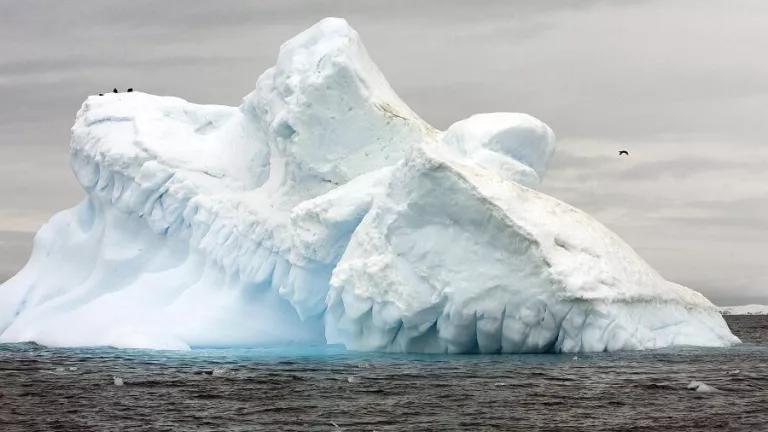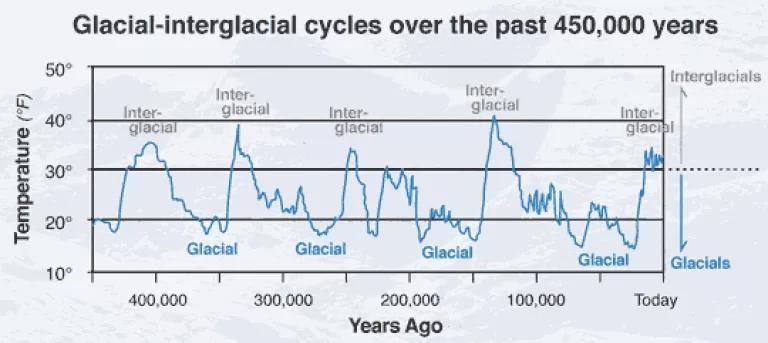How Many Ways Can Ice Melt?
A new study shows how little we know about ice ages, warm periods, and what happens in between.

If you want to test the pharmacokinetics of a drug, you can have as many mice as you want. Looking to improve photovoltaic cells? Take all the sunshine and semiconductors you need. Want to study climate change? Now you have a problem—there’s only one planet earth. That’s the biggest difficulty for a climatologist: Predicting precisely how atmospheric carbon dioxide concentrations will impact the climate and sea level in the next century is extremely difficult with only one earth to study. The entire discipline boils down to solving this single problem.
One approach is to travel through space. The carbon dioxide–rich atmosphere of Venus, whose 900-degree Fahrenheit surface makes life impossible, helped climatologists appreciate the power of greenhouse gases. Another possibility is to travel through time, reconstructing “past earths” and studying how their climates changed in response to different atmospheric conditions. The more past earths we can build, the better we can understand our current climate and how it’s about to change.
Take glaciations, or ice ages. The planet has cycled between heavy ice coverage and relative warmth four times over the past 450,000 years. On a graph, like the one below, the cycles look fairly consistent—long glacial periods interspersed with shorter spikes of heat. Climatologists call this a “sawtooth” pattern.

The only thing this graphs shows, though, is atmospheric temperature changes. Just as important is the melting and sea-level rise that come with them. Our understanding of those consequences comes almost exclusively from the last transition between glacial and interglacial periods, which happened about 20,000 years ago. First came a 2,000-year period during which huge icebergs broke away from ice sheets in the North Atlantic. (Paleoclimatologists call these phenomena “Heinrich events,” and this one is known as “Heinrich Stadial 1.”) Then, as both atmospheric carbon dioxide and trapped energy from the sun increased, there were two periods of rapid glacial melting, separated by a few thousands years of cold.
Climatologists have basically assumed that this is how deglaciation works, because the last transition was the only one we knew anything about. Today, in the journal Nature, a team of researchers in Australia and the United Kingdom gave us our first glimpse of the previous deglaciation, which happened about 135,000 years ago.
By observing the ratio of different isotopes of oxygen contained in mineral deposits in caves, combined with the known radioactive decay rates that generate those isotopes, the authors were able to construct a precise timeline of events, such as the melting of ice sheets and the deposit of previously ice-bound minerals on the floor of the ocean.
The research shows that not every deglaciation is the same. In fact, the transition that happened 135,000 years ago was quite complicated. The Southern Hemisphere warmed rapidly, while the northern half of the globe remained relatively cool due to slow ocean circulation. (Warming in one hemisphere coupled with cooling in the other is known as a polar seesaw.) During this period, the Antarctic ice sheet melted, creating the rather odd phenomenon—at least from the north’s perspective—of rising sea levels accompanied by relatively cool temperatures.
If you’re looking for a neat conclusion about how these new findings prove that global warming is real or that New York will be underwater in 50 years, you’re going to be disappointed. We’ve gone from understanding a single deglaciation to understanding two. This study is just a building block toward figuring out how our ice will melt as the planet warms.
But it’s also about something even bigger than that: It’s about how the atmosphere, the oceans, and the cryosphere (the frozen stuff on our planet) interact. It’s about finding a reason that we swing between freezing and melting and then back to freezing every 100,000 years or so. In other words, it’s about finally understanding how this rock we live on works.
This article was originally published on onEarth, which is no longer in publication. onEarth was founded in 1979 as the Amicus Journal, an independent magazine of thought and opinion on the environment. All opinions expressed are those of the authors and do not necessarily reflect the policies or positions of NRDC. This article is available for online republication by news media outlets or nonprofits under these conditions: The writer(s) must be credited with a byline; you must note prominently that the article was originally published by NRDC.org and link to the original; the article cannot be edited (beyond simple things such grammar); you can’t resell the article in any form or grant republishing rights to other outlets; you can’t republish our material wholesale or automatically—you need to select articles individually; you can’t republish the photos or graphics on our site without specific permission; you should drop us a note to let us know when you’ve used one of our articles.
When Customers and Investors Demand Corporate Sustainability
It’s Time to Talk about Climate Anxiety
How to Find Relief During Summer Heat Waves in the City